上海牛津英语4A-M3知识点总结
上海牛津小学英语4A
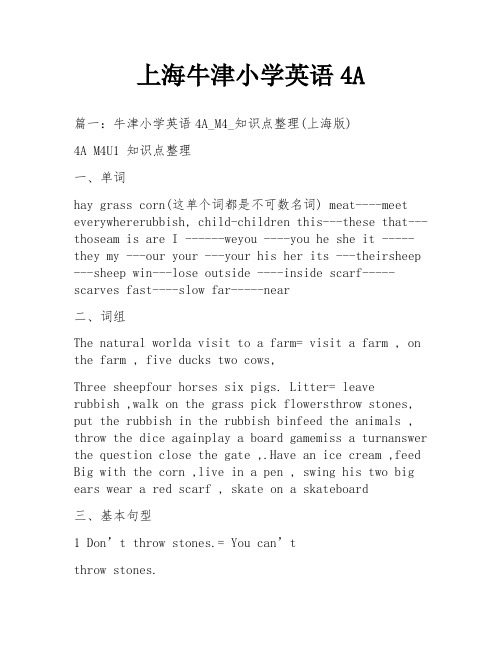
上海牛津小学英语4A篇一:牛津小学英语4A_M4_知识点整理(上海版)4A M4U1 知识点整理一、单词hay grass corn(这单个词都是不可数名词) meat----meet everywhererubbish, child-children this---these that---thoseam is are I ------weyou ----you he she it -----they my ---our your ---your his her its ---theirsheep ---sheep win---lose outside ----inside scarf-----scarves fast----slow far-----near二、词组The natural worlda visit to a farm= visit a farm , on the farm , five ducks two cows,Three sheepfour horses six pigs. Litter= leaverubbish ,walk on the grass pick flowersthrow stones, put the rubbish in the rubbish binfeed the animals , throw the dice againplay a board gamemiss a turnanswer the question close the gate ,.Have an ice cream ,feed Big with the corn ,live in a pen , swing his two big ears wear a red scarf , skate on a skateboard三、基本句型1 Don’t throw stones.= You can’tthrow stones.2 Feed the animals .= You can feed the animals.3 What do they eat? They eat hay.4A M4U2知识点整理一、单词know=no . butter ,candy, sketchbook ,cap ,. camera----cameras, an aviary -------aviaries , fountain, photo -----photos , pond , lovely =cute, where-----wear sign , on ---under,二、词组,at Century Park in the picnic basket, let me see, some peanut butter,have a picnic , take the school bus= go there by bus , be ready for far away from ----near , look at the map of the park ,beautiful flowers and plants, the plant house, some aviaries, next to==beside = near home for birds , go and have a look , of course ==sure,take some photosshow them, beside the fountain,play on the swing , watch the fish and ducks, under the tree, play in the garden,swing veryhigh ,slide very fast三、基本句型1 Where is Century Park?It’s far away from our school.We can take the school bus there.2. What do you have, Danny?I have a cap and a bottle of water.篇二:上海牛津小学英语4a第一模块上海牛津小学英语第一模块测试满分:基础测试70分《不包括听力》Part Ⅰ Vocabulary and Grammar一、抄写句子,注意大小写以及标点符号。
上海 牛津英语 4A M3 unit3In the shop 词汇语法和试卷习题
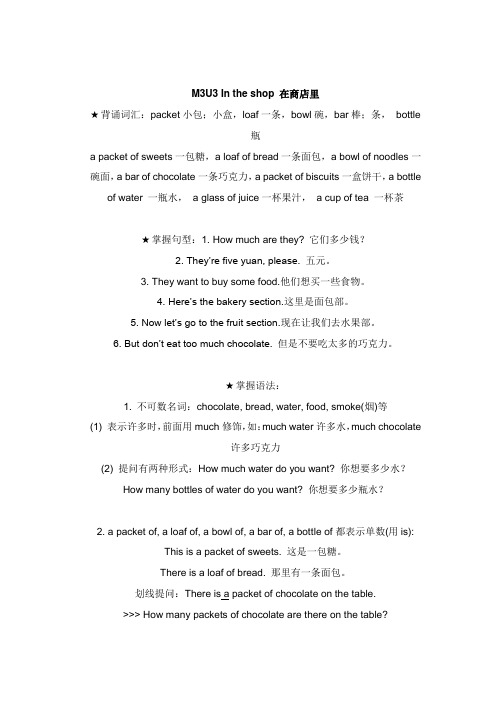
M3U3 In the shop 在商店里★背诵词汇:packet小包;小盒,loaf一条,bowl碗,bar棒;条,bottle瓶a packet of sweets一包糖,a loaf of bread一条面包,a bowl of noodles一碗面,a bar of chocolate一条巧克力,a packet of biscuits一盒饼干,a bottle of water 一瓶水,a glass of juice一杯果汁,a cup of tea 一杯茶★掌握句型:1. How much are they? 它们多少钱?2. They’re five yuan, please. 五元。
3. They want to buy some food.他们想买一些食物。
4. Here’s the bakery section.这里是面包部。
5. Now let’s go to the fruit section.现在让我们去水果部。
6. But don’t eat too much chocolate. 但是不要吃太多的巧克力。
★掌握语法:1. 不可数名词:chocolate, bread, water, food, smoke(烟)等(1) 表示许多时,前面用much修饰,如:much water许多水,much chocolate许多巧克力(2) 提问有两种形式:How much water do you want? 你想要多少水?How many bottles of water do you want? 你想要多少瓶水?2. a packet of, a loaf of, a bowl of, a bar of, a bottle of都表示单数(用is):This is a packet of sweets. 这是一包糖。
There is a loaf of bread. 那里有一条面包。
上海牛津英语4A期末复习词汇和语法汇总1

M1U1 Meeting new peopleM1U1 Meeting new people认识新伙伴★背诵词汇:eleven 11,twelve 12, thirteen 13, fourteen 14, fifteen 15,sixteen16, seventeen 17, eighteen 18, nineteen 19, twenty 20★背诵句型:1.This is my sister. Her name is Sally. 这是我的姐妹,她的名字叫Sally。
2. His name is Paul. He’s only six.他的名字叫Paul,他只有六岁。
3. I’m Peter’s classmate. 我是Peter的同学。
4. We are going to the park.我们正打算去公园。
5. Goodbye, Kitty. 再见,Kitty。
6. See you. 再见。
7. She’s ten years old.她十岁。
8. Her student number is sixteen. 她的学号是16。
9. Nice to meet you.很高兴认识你。
10. Nice to meet you too. 我也很高兴认识你。
★掌握语法:1. 所有格:(1)(物主代词):I—my, you—your, he—his, she—her, it—its, we—our, they—their(2)’s表示“的”:my sister’s book我姐姐的书;Kitty’s pen 凯特的笔(3)以s结尾的复数名词所有格只在s后面加’: the pupils’ bags 学生们的书包(4)用and连接的两个名词所有格形式,只在后面一个名词后加’s:This is Ben and Danny’s ball. 这是Ben和Danny(共有)的球。
(5)These are Ben’s and Danny’s balls. 表示“这些是Ben的以及Danny的球。
牛津上海版4A 课本知识整理

4A 课本知识整理2011.9 班级_______________姓名______________学号_______________M1U 1 P2meet 遇见(同音词:meat ) people 人(复数:people )Peter彼得Kitty凯蒂Sally 萨莉Paul保罗name名字classmate同学sister 姐姐、妹妹brother 哥哥、弟弟only 只有she 她her她的he他his他的park 公园her name她的名字Peter’s classmate 彼得的同班同学go to the park去公园This is my sister. 这是我的姐姐。
Her name’s Sally. 她的名字叫萨莉。
She’s twelve. 她十二岁。
What’s your name? My name is Kitty. 你叫什么名字?我的名字是凯蒂。
We are going to the park. 我们去公园了。
See you. 再见。
P3eleven 11 twelve 12 thirteen 13 fourteen 14 fifteen 15 sixteen 16 seventeen 17 eighteen 18 nineteen 19 twenty 20 show 展示photo照片your 你的friend 朋友then 然后,接着talk 说about 关于him他(宾格)her她(宾格)Danny 丹尼Tracy 特雷西age年龄ride a bicycle 骑自行车This is my friend. 这是我的朋友。
His name’s Danny. 他的名字叫丹尼。
He’s nine. 他九岁了。
He can ride a bicycle. 他会骑自行车。
What’s his name? His name’s Danny. 他的名字是什么?他的名字是丹尼。
上海版牛津英语 4A 语法总复习

25. Danny ____________ (study) English, Chinese, math, science and art at school.
26. Mike sometimes __________ (go) to the park with his sister. 27. At eight at night, she ____________ (watch) TV with her parents.
改错(划出错误的地方,将正确的写在横线上) 1. Is your brother speak English? __________________ 2. Does he likes going fishing? __________________ 3. He likes play games after class. __________________ 4. Mr. Wu teachs us English. __________________
牛津英语4A 语法总复习
1.be 动词的一般现在时的句式: 肯定句:主语+be+其他.
否定句:主语+be+ not+其他.
e.g. He is a worker. You are thirteen. They are in the classroom. e.g. He is not a worker. You aren’t thirteen. They aren’t in the classroom. e.g. Is he a worker? Yes, he is./No, he isn’t. Are you thirteen? Are they in the classroom? Yes, they are. No, they aren’t. e.g. What is he? What colour is that bird? How old are you? Where are they ?
上海牛津英语4A_M3知识点总结

M3U1 In our school一、单词学习:place地点,canteen食堂,computer lab计算机房,lab实验室,office办公室,gym体育馆,classroom教室,music room音乐教室,art room美术教室,library 图书馆,hall礼堂;大厅,playground操场,classroom building教学楼,teachers’ office教师办公室,post office邮局behind在…后面,in front of 在…前面二、词组学习:study with和…一起学习,a lot of = lots of =many=much许多,have lunch吃午餐,have computer lessons上计算机课,have a try试一试三、句型学习:1. This is the teachers’ office. 这是教师办公室。
2. Miss Fang is busy now.方老师正在忙。
3. There are a lot of books in it. 里面有许多的书。
4. We have lunch here. 我们在这里吃午餐。
5. It’s behind the classroom building. 它在教学楼的后面。
6. What’s on this floor? 这层楼是什么?7. We have computer lessons in it. 我们在里面上计算机课。
8. There is a cupboard and a bookshelf in it. 在里面有一个柜子和书架。
9. Your classroom is clean and tidy.你们的教室真干净整洁。
10. Thank you so much. 太感谢你们了。
11. You’re welcome. 不客气。
四、掌握语法:1. There be 句型:(1) “就近原则”(2) There be 句型一般和地点状语连用There is a book and some pens on the desk.There are some pens and a book on the desk.There is a playground behind the classroom building.(3) 否定形式:There is some water. >>> There isn’t any water.There are some books. >>> There aren’t any books.(4) 一般疑问句和回答:Is there any water? Yes, there is. / No, there isn’t.Are there any books? Yes, there are. / No, there aren’t.(5) 用wha t’s划线提问:There is a book in the bag. >>> What’s in the bag?There are many books in the bag.>>> What’s in the bag?(6) How many提问一般用there be 句型回答:How many books are there on the desk? There are ten books on the desk. How many girls? There are eleven.2. 复数:library---libraries, bookshelf书架---bookshelves3. 反义词:clean干净的---dirty脏的,bad坏的---good好的little---old/ big4. 一些常用口语:Thank you so much.= Thanks a lot. 多谢。
牛津英语4a知识点
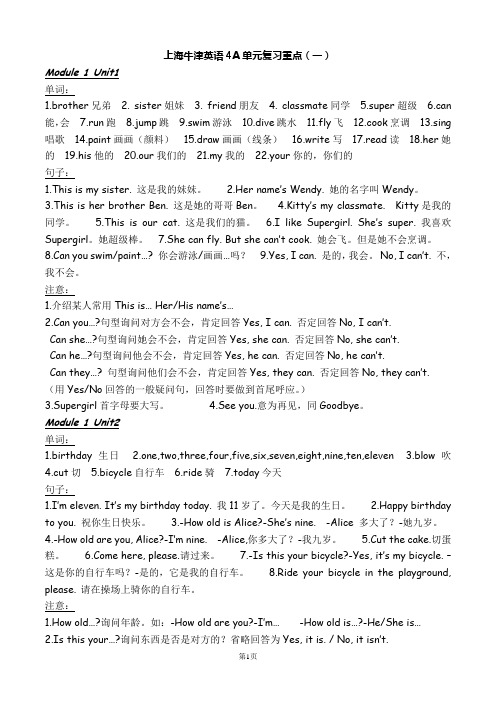
单词:1.brother兄弟2. sister姐妹3. friend朋友4. classmate同学5.super超级6.can 能,会7.run跑8.jump跳9.swim游泳10.dive跳水11.fly飞12.cook烹调13.sing 唱歌14.paint画画(颜料)15.draw画画(线条)16.write写17.read读18.her她的19.his他的20.our我们的21.my我的22.your你的,你们的句子:1.This is my sister. 这是我的妹妹。
2.Her name’s Wendy. 她的名字叫Wendy。
3.This is her brother Ben. 这是她的哥哥Ben。
4.Kitty’s my classmate. Kitty是我的同学。
5.This is our cat. 这是我们的猫。
6.I like Supergirl. She’s super. 我喜欢Supergirl。
她超级棒。
7.She can fly. But she can’t cook. 她会飞。
但是她不会烹调。
8.Can you swim/paint…? 你会游泳/画画…吗?9.Yes, I can. 是的,我会。
No, I can’t. 不,我不会。
注意:1.介绍某人常用This is… Her/His name’s…2.Can you…?句型询问对方会不会,肯定回答Yes, I can. 否定回答No, I can’t.Can she…?句型询问她会不会,肯定回答Yes, she can. 否定回答No, she can’t.Can he…?句型询问他会不会,肯定回答Yes, he can. 否定回答No, he can’t.Can they…? 句型询问他们会不会,肯定回答Yes, they can. 否定回答No, they can’t.(用Yes/No回答的一般疑问句,回答时要做到首尾呼应。
牛津上海版4A期末重点知识点整理M3U1-M3U2
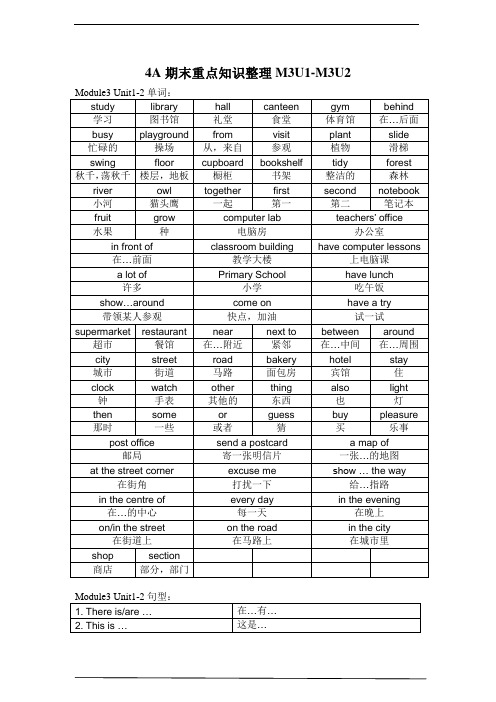
是,有的。/不,没有。
9. Where is…?
…在哪里?
It’sat+具体的地址
它在…
10. I want to…
我想要…
11. Let me see.
让我想一想。
12. Thank you so much.
非常感谢你。
It’s my/our pleasure.
2.掌握日常用语:
What’s the matter?
I don’t think so.
Thank youso much.-You are welcome.
3.掌握There be句型的一般疑问句形式及其回答。
Is there a shop near here?这附近有商店吗?
- Yes, there is.是,有的。
5. I don’t think so.
我不这么认为。
6.Thank youso much.
非常感谢。
You are welcome.
不用谢。
7. Is there…?
这里有…吗?
Yes, there is. / No, there isn’t.
是,有的。/不,没有。
8. Are there…?
这里有…吗?
Are there a lot of people in the park?
- No, there aren’t.不,没有。
4.掌握疑问代词Where引导的特殊疑问句。
Where is your home, Jill?你家在哪里,Jill?
5.掌握地址表述方法。
It’s at No.126, Garden Street.我家在花园街126号。
上海版牛津英语4A复习资料

Module 1 Getting to know you.Unit 1 Hello again!1. This is … 这是…例:This is my friend. 这是我的朋友。
2. See you. 再见。
3. can+动词原形有能力(做…)can't+动词原形不能(做…)例:She can run. 她能跑。
She can't run. 她不能跑。
4. Can you …? Yes,I can . / No,I can't. 你会做…吗?是的,我会做。
/ 不,我不会做。
例:Can you swim ? Yes,I can (swim) . / No,I can't (swim). 你会游泳吗?是的,我会(游泳)。
/ 不,我不会(游泳)。
Unit 2 How old are you?1. How old is … ? He's / She's…. (询问第三人称的年龄)…几岁了?他/她…岁了。
例:How old is Alice ? She's nine. 爱丽丝几岁了?她九岁了。
2. Happy birthday (to you). (祝你)生日快乐。
3. Is this your …? Yes,it's …./No,it isn't …. 这是你的…吗?是的,它是…。
/ 不。
它不是…。
例:Is this your ruler ? Yes,it's my ruler . / No,it isn't my ruler. 这是你的尺子吗?是的,它是我的尺子。
/ 不,它不是我的尺子。
4. Come here. 到这里来。
(祈使句)5. Ride your bicycle in the playground,please. 请在操场骑自行车。
(祈使句)Unit 3 What do you do?1. What does your …do ? He’s / She’s …. 询问他人(第三人称)的职业。
上海牛津英语4a知识点汇总(K12教育文档)
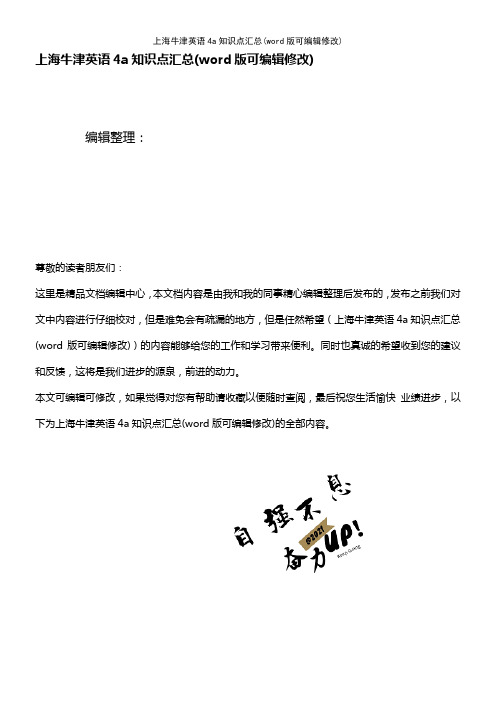
上海牛津英语4a知识点汇总(word版可编辑修改)编辑整理:尊敬的读者朋友们:这里是精品文档编辑中心,本文档内容是由我和我的同事精心编辑整理后发布的,发布之前我们对文中内容进行仔细校对,但是难免会有疏漏的地方,但是任然希望(上海牛津英语4a知识点汇总(word版可编辑修改))的内容能够给您的工作和学习带来便利。
同时也真诚的希望收到您的建议和反馈,这将是我们进步的源泉,前进的动力。
本文可编辑可修改,如果觉得对您有帮助请收藏以便随时查阅,最后祝您生活愉快业绩进步,以下为上海牛津英语4a知识点汇总(word版可编辑修改)的全部内容。
上海牛津英语4a知识点汇总M1U1 Meeting new people1.词汇: classmate 同学 schoolmate 校友 deskmate 同桌 friend朋友meet 遇见people人们 eleven 十一 twelve十二thirteen 十三 fourteen 十四 fifteen 十五 sixteen 十六 seventeen 十七 eighteen 十八 nineteen 十九 twenty二十student number 学号 sit 坐 skip跳绳 live居住 near在……附近 year年well好 mask 面具2.词组: my classmate 我的同学 go to the park 去公园 ride a bicycle骑自行车 skipa rope 跳绳 live near the school住在学校附近 walk to school走路去学校 playbasketball 打篮球 like reading喜欢阅读 years old 岁—Nice to meet you!很高兴遇到你!-Nice to meet you,too.我也很高兴遇到你!See you!再见!3.语法:形容词性物主代词 his,her,your,my,its,their,our形容词性物主代词(所有格)后必须加名词。
上海牛津英语 小学4A M1U3笔记
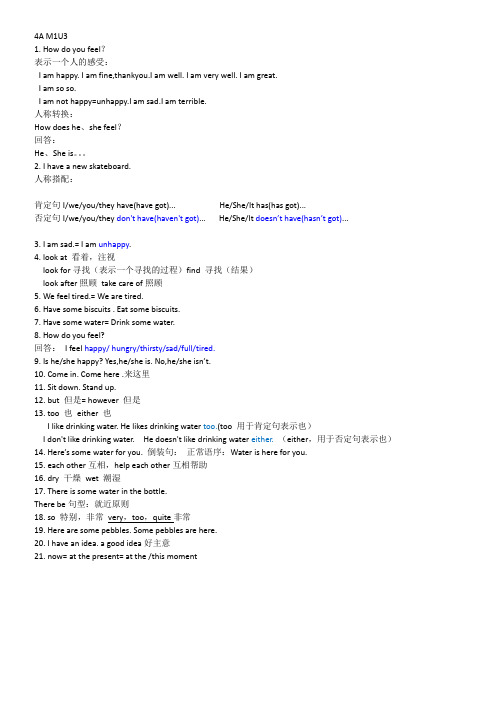
4A M1U31.How do you feel?表示一个人的感受:I am happy. I am fine,thankyou.I am well. I am very well. I am great.I am so so.I am not happy=unhappy.I am sad.I am terrible.人称转换:How does he、she feel?回答:He、She is。
2.I have a new skateboard.人称搭配:肯定句I/we/you/they have(have got)... He/She/It has(has got)...否定句I/we/you/they don't have(haven't got)... He/She/It doesn’t have(hasn’t got)...3.I am sad.= I am unhappy.4.look at 看着,注视look for寻找(表示一个寻找的过程)find 寻找(结果)look after照顾take care of照顾5.We feel tired.= We are tired.6.Have some biscuits . Eat some biscuits.7.Have some water= Drink some water.8.How do you feel?回答:I feel happy/ hungry/thirsty/sad/full/tired.9.Is he/she happy? Yes,he/she is. No,he/she isn’t.e in. Come here .来这里11.Sit down. Stand up.12.but 但是= however 但是13.too 也either 也I like drinking water. He likes drinking water too.(too 用于肯定句表示也)I don't like drinking water. He doesn't like drinking water either.(either,用于否定句表示也)14.Here’s some water for you. 倒装句:正常语序:Water is here for you.15.each other互相,help each other互相帮助16.dry 干燥wet 潮湿17.There is some water in the bottle.There be句型:就近原则18.so 特别,非常very,too,quite非常19.Here are some pebbles. Some pebbles are here.20.I have an idea. a good idea好主意21.now= at the present= at the /this moment。
(完整版)上海牛津英语4a知识点汇总,推荐文档

上海牛津英语4a知识点汇总M1U1 Meeting new people1.词汇:classmate 同学schoolmate 校友deskmate 同桌friend朋友meet 遇见people人们eleven 十一twelve十二thirteen 十三fourteen 十四fifteen 十五sixteen 十六seventeen 十七eighteen 十八nineteen 十九twenty二十student number 学号sit 坐skip跳绳live居住near在……附近year年well好mask 面具2.词组:my classmate 我的同学go to the park 去公园ride a bicycle骑自行车skip arope 跳绳live near the school住在学校附近walk to school走路去学校playbasketball 打篮球like reading喜欢阅读years old 岁—Nice to meet you!很高兴遇到你!—Nice to meet you,too.我也很高兴遇到你!See you!再见!3.语法:形容词性物主代词his,her,your,my,its,their,our形容词性物主代词(所有格)后必须加名词。
my new classmate her dress our classroom his motherHis/Her name is……This is my sister.Her name’s Sally.(向别人介绍某个人)Can 句型can后的动词必须是原形He can swim very fast. He can’t sing.Can he climb a tree?主语是第一人称I、we,第二人称you和第三人称复数they、his parents等的时候,句中动词用原形;主语是第三人称单数时,动词要相应变化(加s)She lives near our school. She walks to school every day.My friend has a nice dress。
[资料]修订版上海牛津英语4A_各unit_词汇整理
![[资料]修订版上海牛津英语4A_各unit_词汇整理](https://img.taocdn.com/s3/m/d9ce7e0aa200a6c30c22590102020740be1ecdec.png)
[资料]修订版上海⽜津英语4A_各unit_词汇整理上海⽜津英语4A词汇整理Module1 Unit 1Words:⼗⼀⼗⼆⼗三⼗四⼗五⼗六遇见⼈姐妹兄弟名字仅仅班级同学朋友照⽚年龄年龄学⽣数字居住⾛路篮球⾜球学校课桌⾯具有趣的⼤笑Phrases:big sister 我的⼤姐姐 name 她的名字brother 他的兄弟’s classmate Peter的同班同学 to the park 去公园 photo of your friend你朋友的照⽚ a bicycle 骑⾃⾏车 a rope 跳绳years old ⼗⼆岁 year old ⼀岁number 学号 here 坐这⼉day 每天 our school 在我们学校附近basketball打篮球 new student ⼀位新学⽣at his desk坐在他的课桌旁 funny mask ⼀个有趣⾯具Sentences:1. Her name is Sally. = Her name’s Sally. 她的名字叫Sally。
2. I’m Peter’s classmate. 我是Peter的同班同学。
3. He is only six years old. 他只有六岁。
4. Her student number is sixteen. 她的学号是⼗六号。
5. We have a new classmate. 我们有⼀位新同学。
6. She lives near our school. 她住在学校附近。
7. She walks to school every day. 她每天⾛出学校。
8. Jill likes reading, and she can play basketball well.Jill 喜欢阅读,⽽且她很会打篮球。
⼀、主格,所有格和宾格⼆、数字M1U2Words:游泳绘画读书写字⽤颜料画画跳图画快速 9.好well ⾼⾮常九⽉谁跳绳单脚跳爬海豚猴⼦兔⼦鸟梦访问客⼈每⼈超级两个都傍晚欢迎时间薯⽚黄蜂⼩马能⼒Phrases:fast跑得快 well 游得好3. fly high 飞得⾼ a picture画⽔彩画,(⽤颜料)画画the trees 爬树 student 这个学⽣to three 数到三 evening 晚上好to our class欢迎到我们班级来wasps ⼩黄蜂 away ⾛开Sentences:1. Can Supergirl paint a picture? 超级⼥孩会画⽔彩画吗?2. No,she can’t ,but she can run fast. 她不会,但她跑步很快。
英语(上海版)4A总结
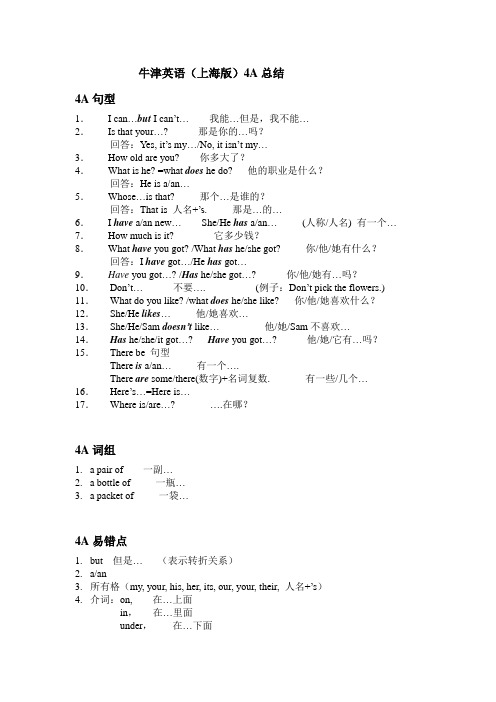
牛津英语(上海版)4A总结4A句型1.I can…but I can’t…我能…但是,我不能…2.Is that your…? 那是你的…吗?回答:Yes, it’s my…/No, it isn’t my…3.How old are you? 你多大了?4.What is he? =what does he do? 他的职业是什么?回答:He is a/an…5.Whose…is that? 那个…是谁的?回答:That is 人名+’s.那是…的…6.I have a/an new…She/He has a/an…(人称/人名) 有一个…7.How much is it? 它多少钱?8.What have you got? /What has he/she got? 你/他/她有什么?回答:I have got…/He has got…9.Have you got…? /Has he/she got…? 你/他/她有…吗?10.Don’t…不要…. (例子:Don’t pick the flowers.) 11.What do you like? /what does he/she like? 你/他/她喜欢什么?12.She/He likes…他/她喜欢…13.She/He/Sam doesn’t like…他/她/Sam不喜欢…14.Has he/she/it got…? Have you got…? 他/她/它有…吗?15.There be 句型There is a/an…有一个….There are some/there(数字)+名词复数. 有一些/几个…16.Here’s…=Here is…17.Where is/are…? ….在哪?4A词组1. a pair of 一副…2. a bottle of 一瓶…3. a packet of 一袋…4A易错点1.but 但是…(表示转折关系)2.a/an3.所有格(my, your, his, her, its, our, your, their, 人名+’s)4.介词:on, 在…上面in,在…里面under,在…下面1、缩略形式和完整形式:That’s = that is what’s = what is where’s = where is it’s = it is he’s = he is she’s = she isI’m = I am you’re = you are they’re = they are isn’t = is n ot don’t = do not。
《 牛津4A 》重点知识点总结
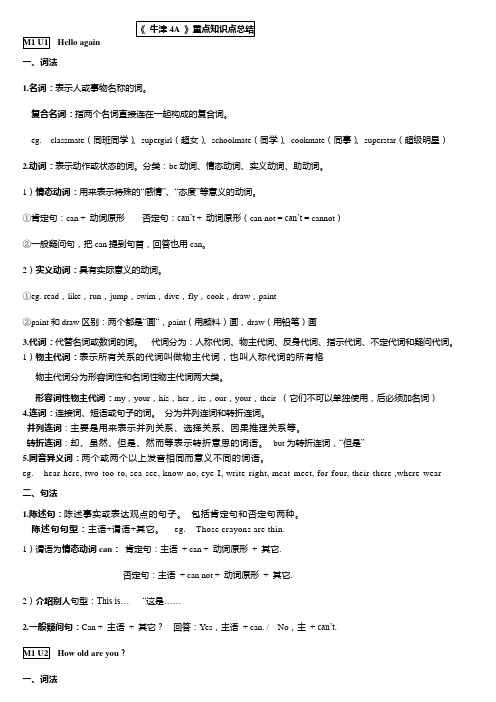
Hello again一、词法1.名词:表示人或事物名称的词。
复合名词:指两个名词直接连在一起构成的复合词。
eg. classmate(同班同学)、supergirl(超女)、schoolmate(同学)、cookmate(同事)、superstar(超级明星)2.动词:表示动作或状态的词。
分类:be动词、情态动词、实义动词、助动词。
1)情态动词:用来表示特殊的“感情”、“态度”等意义的动词。
①肯定句:can + 动词原形否定句:can’t + 动词原形(can not = can’t = cannot)②一般疑问句,把can提到句首,回答也用can。
2)实义动词:具有实际意义的动词。
①eg. read,like,run,jump,swim,dive,fly,cook,draw,paint②paint和draw区别:两个都是“画“,paint(用颜料)画,draw(用铅笔)画3.代词:代替名词或数词的词。
代词分为:人称代词、物主代词、反身代词、指示代词、不定代词和疑问代词。
1)物主代词:表示所有关系的代词叫做物主代词,也叫人称代词的所有格物主代词分为形容词性和名词性物主代词两大类。
形容词性物主代词:my,your,his,her,its,our,your,their (它们不可以单独使用,后必须加名词)4.连词:连接词、短语或句子的词。
分为并列连词和转折连词。
并列连词:主要是用来表示并列关系、选择关系、因果推理关系等。
转折连词:却、虽然、但是、然而等表示转折意思的词语。
but为转折连词,“但是”5.同音异义词:两个或两个以上发音相同而意义不同的词语。
eg. hear-here, two-too-to, sea-see, know-no, eye-I, write-right, meat-meet, for-four, their-there ,where-wear二、句法1.陈述句:陈述事实或表达观点的句子。
牛津英语上海版4A知识点梳理
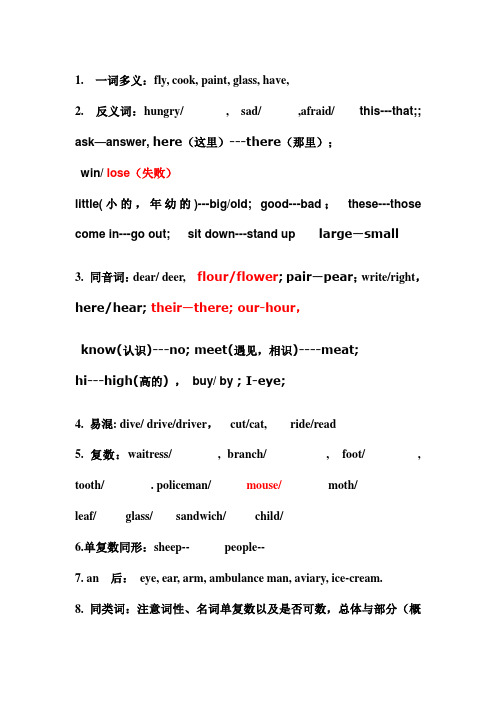
1. 一词多义:fly, cook, paint, glass, have,2. 反义词:hungry/ , sad/ ,afraid/ this---that;; ask—answer, here(这里)---there(那里);win/ lose(失败)little(小的,年幼的)---big/old; good---bad;these---those come in---go out; sit down---stand up large—small3. 同音词:dear/ deer, flour/flower; pair—pear;write/right,here/hear; their—there; our-hour,know(认识)---no; meet(遇见,相识)----meat;hi---high(高的) ,buy/ by ; I-eye;4. 易混: dive/ drive/driver,cut/cat, ride/read5. 复数:waitress/ , branch/ , foot/ , tooth/ . policeman/ mouse/ moth/leaf/ glass/ sandwich/ child/6.单复数同形:sheep-- people--7. an 后:eye, ear, arm, ambulance man, aviary, ice-cream.8. 同类词:注意词性、名词单复数以及是否可数,总体与部分(概括与举例)9. 动词第三人称单数形式:have/ , like/ , eat/ , do/ go/ .10. 物主代词:my, his, ...11. 宾格:me/ him/ her...You can call me...宾格:(1)I---me, you---you, he---him, she---her, it---it, we---us, they---them(2)宾格放在动词或介词的后面:Look at me. 看着我。
牛津上海版4A期末重点知识点整理M3U3-M4U1

Don’t throw stones.
rubbish bin
不要摘花
不要乱扔石头
垃圾箱
visit the farm
on the farm
参观农场
在农场
Module3 Unit3-Module4 Unit1句型:
1. How much is it?
它多少钱?
It’s…yuan.
这是…
8. He/She(第三人称单数)+动词s
Module3 Unit3-Module4 Unit1语言点:
1.掌握疑问代词How much引导的特殊疑问句。
How much is it?–It’s twelve yuan.这个多少钱?- 12元。
2.掌握情态动词May引导的句子,表示询问对方是否可以做某事。
a packet of biscuits
a bottle of water
a piece of paper
一包饼干
一瓶水
一张纸
a pair of jeans
a cup of tea
bakery section
一条牛仔裤
一杯茶
面包区
fruit section
all right
too much
水果区
好的
它…元。
2. How much are they?
它们多少钱?
They’re…yuan.
它们…元。
3. MayI…?
我可以…吗?
All right.
好的。
4. On his farm he has…
他农场上有…
5. Don’t…
不要…
牛津小学英语4AM3知识点整理(上海版)

一、单词Place--------places , activity -----------activities , canteen , lab , classroom , music room , office------an office , bookshelf -----------bookshelves, hall , busy------free , playground ,garden , cupboard, good---------bad, notebook , fruit, many-------a lot of , owl ----an owl , clean----dirty , tidy--------untidy , animal----an animal . pencil case, behind, in front oflet’s -------let us二、词组in our school, study with Kim , an English teacher , welcome to , a visit to Rainbow Primary School , behind the classroom building , the teachers’office , have lunch , from the UK, show him around on this floor, a small river , have a try , run together , the first, the second, grow the fruit, give me some fruit三、基本句型;1 What’s in your school? There is a computer lab in my school.2 What’s in your bag? There are some rubbers in my bag.3 Where’s the playground? It’s behind the classroom building.4 How many libraries are there in your school? There is one.一、单词Supermarket , post office , restaurant , bakery------------bakeries , hotel , neighbourhood, ,next to = beside = near , where--------wear , city –cities , guess, bright-------dark beautiful bread---------toast in the centre of .二、词组Around my home , at No.126 Garden Street , on a busy street , in our city , on Park Street , excuse me , send a postcard to Tom , buy some bread , clothes shop , show you the way , count the snakes,三、基本句型:1 Where is your home ? It’s at No.126 ,Garden Street .2 There is a supermarket, some shops, some restaurants, and a parkThere are some shops, a supermarket, some restaurants , and a park.(There be 就近一致,这两个句子意思相同)3 Thank you so much ----------It’s my pleasure.( It’s our pleasure)四背诵Nanjing Road-------A busy road in ShanghaiNanjing Road is in the centre of Shanghai .It’s very busy. Every day many people go to Nanjing Road and visit the shops .They can buy clothes, clocks and watches, food and many other things there, They can also eat in the restaurants or stay in the hotels there.Many people visit Nanjing Road in the evening . The lights are bright and beautiful then.4A M3U3 知识点整理一、单词Doggie= puppy , mole , smoke , spider , hope二、词组bookshop ,some sticks A small packet of sweets a loaf of bread (two loaves of bread ) a bowl of noodles, , three large bars of chocolate , a packet of biscuits, a bottle of water, in the supermarket , want to buy some food , the bakery section , go to the fruit section , much chocolate, a glasses shop , a pair of glasses forest yuan an elephant , of course , play together , don’t worry , put on ---take off , these magic glasses, with a waggly tail , for sale the food shop , the toy shop, the三、基本句型1 How much is it?It’s twelve yuan。
完整)上海牛津版四年级英语4A复习整理

完整)上海牛津版四年级英语4A复习整理Unit 1 (Module 1) Meet New PeopleIn this unit。
we will learn some new words and basic XXX.Words: XXX。
XXX。
XXX。
fourteen。
fifteen。
sixteen。
XXX。
XXX。
XXX。
twenty。
classmate。
know。
meet。
people。
schoolmate。
number。
school number。
near。
walk to school。
go to school on foot。
every day。
like reading。
play basketball。
play football。
a new student.Basic XXX Structures:This is。
(n)See you。
(goodbye)Nice to see you。
(greeting)Nice to see you too。
(response to greeting)Grammar:1.Adjective Possessive Pronouns: my。
her。
his。
yourIn English。
possessive pronouns XXX adjectives and come before the noun they modify。
They must be followed by a noun.For example: This is my brother。
His name is Tom.Adjective possessive pronouns change based on person and number:Singular: my。
your。
his/her/itsPlural: our。
your。
their2.Modal Verb "Can"Can" must be followed by a verb in its base form。
- 1、下载文档前请自行甄别文档内容的完整性,平台不提供额外的编辑、内容补充、找答案等附加服务。
- 2、"仅部分预览"的文档,不可在线预览部分如存在完整性等问题,可反馈申请退款(可完整预览的文档不适用该条件!)。
- 3、如文档侵犯您的权益,请联系客服反馈,我们会尽快为您处理(人工客服工作时间:9:00-18:30)。
M3U1 In our school1.单词:place地点,canteen食堂,computerlab计算机房,lab实验室,office办公室,gym体育馆,classroom教室,music room 音乐教室,art room美术教室,library图书馆,hall礼堂;大厅,playground 操场,classroombuilding教学楼,teachers’office教师办公室,post office邮局behind在…后面,in front of 在…前面2. 词组: studywith和…一起学习, alot of=lots of =many=much许多,havelunch吃午餐,have computer lessons上计算机课,have a try试一试ﻫ3. 句型1). Thisis the teachers’ office.这是教师办公室。
ﻫ2). Miss Fangis busy now.方老师正在忙。
ﻫ3). Therearealot ofbooksinit.里面有许多的书。
ﻫ4). We have lunchhere.我们在这里吃午餐。
5). It’sbehind the classroombuilding.它在教学楼的后面。
7). We have com6).What’s on this floor? 这层楼是什么?ﻫputer lessonsin it. 我们在里面上计算机课。
ﻫ8).There is acupboard and abookshelf init. 在里面有一个柜子和书架。
9). Your classroom is clean and tidy.你们的教室真干净整洁。
10). Thank you so much. 太感谢你们了。
ﻫ11).You’re welcome. 不客气。
4.语法:ﻫ1). There be 句型: ﻫ(1)“就近原则”(2)There be 句型一般和地点状语连用ﻫThere is a book and some pens on the desk.ﻫThere aresome pensand a boo konthedesk.ﻫThereis a playground behind the classroom building. ﻫ(3) 否定形式:Thereis some water. >>> Thereisn’t any water.Thereare somebooks.>>>Therearen’tanybooks.(4)一般疑问句和回答:Is there anywater? Yes, there is./No,there isn’t. ﻫAre thereanybooks? Yes,there are. /No, therearen’t. ﻫ(5) 用what’s划线提问: There isabookinthebag.>>>What’s in the bag? ﻫThereare many books in the bag.>>>Wh at’s in the bag? (6)How many提问一般用there be句型回答: ﻫHow many books are there on thedesk?There are ten booksonthe desk.How many girls? There are eleven.2). 复数:library---libraries, bookshelf书架---bookshelvesﻫ3).反义词:clean干净的---dirty脏的,bad坏的---good好的little---old /bigﻫ4). 一些常用口语:Thank you somuch.=Thanks a lot. 多谢。
There are no classrooms.= There are not any classrooms.那里没有教室。
ﻫWhat’s the matter?怎么了?发生什么事了?Idon’t think so.我不这么认为。
ﻫPlease don’t be sad.请不要难过。
Come on, everyone!大家快点啊! ﻫHaveatry, Little Rabbit.小兔试一试。
I’mthe first. 我是第一名。
ﻫI’m thesecond.我是第二名。
M3U2 Around my home1.单词:around周围,home家, street街,road路, near在附近,city城市(复数:cities),shop商店,supermarket超市,post office邮局,restaurant餐厅,clothes shop服装店,ba kery面包店,hotel宾馆,nextto紧邻;在近旁=beside在旁边,between在…中间2.句型:1).Whereis your home?你的家在哪里?2).It’s at No. 126,Garden Street.它在花园街126号。
ﻫ3).There are manyshopsnear myhome.有许多商店在我家附4). It’s on abusystreet inour city. 它在我们城市里的一条繁忙的街上。
ﻫ5). Excuse me,girls.女孩们,抱歉打扰一下。
6). I want tosend apostcard.我想要寄一张明信片。
8).7).I want tobuy some breadtoo. 我还想买一些面包。
ﻫLet mesee.让我想一想。
ﻫ9).There aren’t anycloth10). We can s es shops on thisstreet.在这条街上没有服装店。
ﻫhow you theway.我们可以给你带路。
11).It’s mypleasure. 乐意为您效劳。
12). NanjingRoad isin thecentre of Shanghai.南京路在上海的中心。
3.语法:1. street街,road路:(1) 表示具体某条街或路时要大写:Garden Street花园街,Nanjing Road 南京路(2) 在某条街或路上用介词on:on Garden Street, on Nanjing Road,on a busy street(3)有具体门牌号用介词at: at No. 126,GardenStreet2. shop商店(动词:购物goshopping),前面加名词,表示商店类别:clothes shop服装店,toy shop玩具店,fruit shop水果店,flower shop花店,bookshop书店(注意:bookshop是一个单词,不要分开写) ﻫM3U3 Intheshop1.单词/词组packet小包;小盒,loaf一条,bowl碗,bar棒;条,bottle瓶a packet of sweets一包糖,a loafof bread一条面包,a bowlofnoodles一碗面,abar ofchocolate一条巧克力,a packet ofbiscuits一盒饼干,a bottle of water 一瓶水,a glass of juice一杯果汁, acup of tea一杯茶2.句型学习:1). How much are they?它们多少钱?2).They’re fiveyuan, please. 五元。
3). Theywant tobuy somefood.他们想买一些食物。
ﻫ4). Here’5).Nowlet’s goto th sthebakery section.这里是面包部。
ﻫefruit section.现在让我们去水果部。
ﻫ6). Butdon’t eat too muchchocolate. 但是不要吃太多的巧克力。
3.语法:1.不可数名词:chocolate,bread, water,food,smoke(烟)等ﻫ(1)表示许多时,前面用much修饰,如:much water许多水,much chocolate许多巧克力(2) 提问有两种形式:How muchwaterdo youwant? 你想要多少水?ﻫHow manybottles of water do youwant? 你想要多少瓶水?2. a packetof, aloafof, a bowl of, a bar of,a bottle of都表示单数(用is):ﻫThis isapacket ofsweets. 这是一包糖。
There is a loaf of bread.那里有一条面包。
ﻫ划线提问:There isapacketofchocolate on thetable.ﻫ>>> How many packet s of chocolate are there on the table?(How many 后跟复数, packet加s, there is改成are there)复数:two packets of,three loaves of, four bowls of, five bars of,ten bottlesofﻫ3.want用法:(1) want+ 名词:I want anapple. I want somewater.Iw ant abowlof noodles.(2)want to +动词:Iwant toplay. I want tobuy somefood. ﻫ(3) 划线提问:I want abook.>>>What do you wan t? 你想要什么? ﻫHewants arobot. >>> W hat does he want?他想要什么? ﻫI want to slee p.>>> What do you want to do?你想要做什么?Kitty wants tosing. >>>What does Kitty want to do?Kitty想要做什么?。
